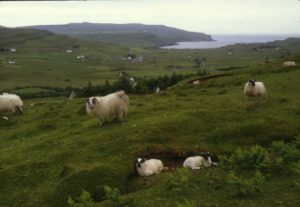Worms in sheep: low risk grazing = better LWG
20 September 2016 Low risk grazing can be described as field where there are few or no infectious worm larvae on the grass. It is sometimes called clean grazing. The opposite would be high risk, or dirty, grazing which is a field with large numbers of infectious worm larvae on the grass. Knowing which is which matters because of the effect on lamb growth rates. Infection with worms reduces dry matter intake and damages the lining of the abomasum and intestines. Lambs eat less and don’t digest and absorb food efficiently. Protein leaks into the damaged gut and is also needed for healing and repair plus an anti-worm immune response. Lambs stocked on high risk grazing have to face a daily assault from huge numbers of worm larvae that they eat along with the grass. Even if you worm them every three weeks (costly in time and money) they will not grow as well as lambs stocked on low risk grazing. At this time of year the following fields would count as low risk grazing:
Low risk grazing can be described as field where there are few or no infectious worm larvae on the grass. It is sometimes called clean grazing. The opposite would be high risk, or dirty, grazing which is a field with large numbers of infectious worm larvae on the grass. Knowing which is which matters because of the effect on lamb growth rates. Infection with worms reduces dry matter intake and damages the lining of the abomasum and intestines. Lambs eat less and don’t digest and absorb food efficiently. Protein leaks into the damaged gut and is also needed for healing and repair plus an anti-worm immune response. Lambs stocked on high risk grazing have to face a daily assault from huge numbers of worm larvae that they eat along with the grass. Even if you worm them every three weeks (costly in time and money) they will not grow as well as lambs stocked on low risk grazing. At this time of year the following fields would count as low risk grazing:
- Not grazed by sheep this year e.g. re-seed, only grazed by cattle.
- Alternative forages e.g. brassicas, chicory, stubble fields (beware of the possible risk of infection from grass run backs).
High risk fields to be avoided if possible would include:
- Fields heavily stocked by ewes and lambs this year.
Wherever possible try and provide an area of low risk grazing for weaned lambs. For more information on managing pasture for worm control see www.scops.org.uk.
Heather Stevenson, heather.stevenson@sac.co.uk.
Sign up to the FAS newsletter
Receive updates on news, events and publications from Scotland’s Farm Advisory Service
